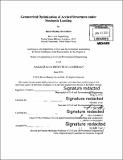| dc.contributor.advisor | Corentin Fivet and John Ochsendorf. | en_US |
| dc.contributor.author | Brownfield, Daniel Bradley | en_US |
| dc.contributor.other | Massachusetts Institute of Technology. Department of Civil and Environmental Engineering. | en_US |
| dc.date.accessioned | 2016-09-13T19:10:22Z | |
| dc.date.available | 2016-09-13T19:10:22Z | |
| dc.date.copyright | 2016 | en_US |
| dc.date.issued | 2016 | en_US |
| dc.identifier.uri | http://hdl.handle.net/1721.1/104189 | |
| dc.description | Thesis: M. Eng., Massachusetts Institute of Technology, Department of Civil and Environmental Engineering, 2016. | en_US |
| dc.description | Cataloged from PDF version of thesis. | en_US |
| dc.description | Includes bibliographical references (pages 53). | en_US |
| dc.description.abstract | This thesis presents a method for determining the moment-optimized shape y(x) for arched structures under unpredictable loading scenarios. A frame geometry optimization derivation is presented that demonstrates the relationship between certain unpredicted loads and an equivalent guaranteed loading condition that is more easily solvable through standard equilibrium analysis. The relationship is then broadened to generate the geometric form for arches experiencing randomly applied point loads over continuous intervals. The conclusions from the frame derivation and subsequent applications are summarized in a generalizable conjecture regarding stochastic loading, which states that the moment-optimized arch geometry y₁(x), when subjected to a random point load P with a likelihood of occurrence determined by a probability density function f(x), is equal to the zero-moment solution y₂(x) for an arch subjected to a distributed load u(x) when f(x) = u(x). The conjecture is further reinforced by form-finding models programmed to minimize maximum moments under stochastic loading using structural analysis software. Conceding an extensive range of applicability, this relationship is a direct asset when considering the design of structures subjected to projectile impacts, the location of which are oftentimes unpredictable. As such, an in-progress military shelter development project is examined as a case study to demonstrate the practicality of the theorem. | en_US |
| dc.description.statementofresponsibility | by Daniel Bradley Brownfield. | en_US |
| dc.format.extent | 53 pages | en_US |
| dc.language.iso | eng | en_US |
| dc.publisher | Massachusetts Institute of Technology | en_US |
| dc.rights | M.I.T. theses are protected by copyright. They may be viewed from this source for any purpose, but reproduction or distribution in any format is prohibited without written permission. See provided URL for inquiries about permission. | en_US |
| dc.rights.uri | http://dspace.mit.edu/handle/1721.1/7582 | en_US |
| dc.subject | Civil and Environmental Engineering. | en_US |
| dc.title | Geometrical optimization of arched structures under stochastic loading | en_US |
| dc.type | Thesis | en_US |
| dc.description.degree | M. Eng. | en_US |
| dc.contributor.department | Massachusetts Institute of Technology. Department of Civil and Environmental Engineering | |
| dc.identifier.oclc | 958136856 | en_US |
